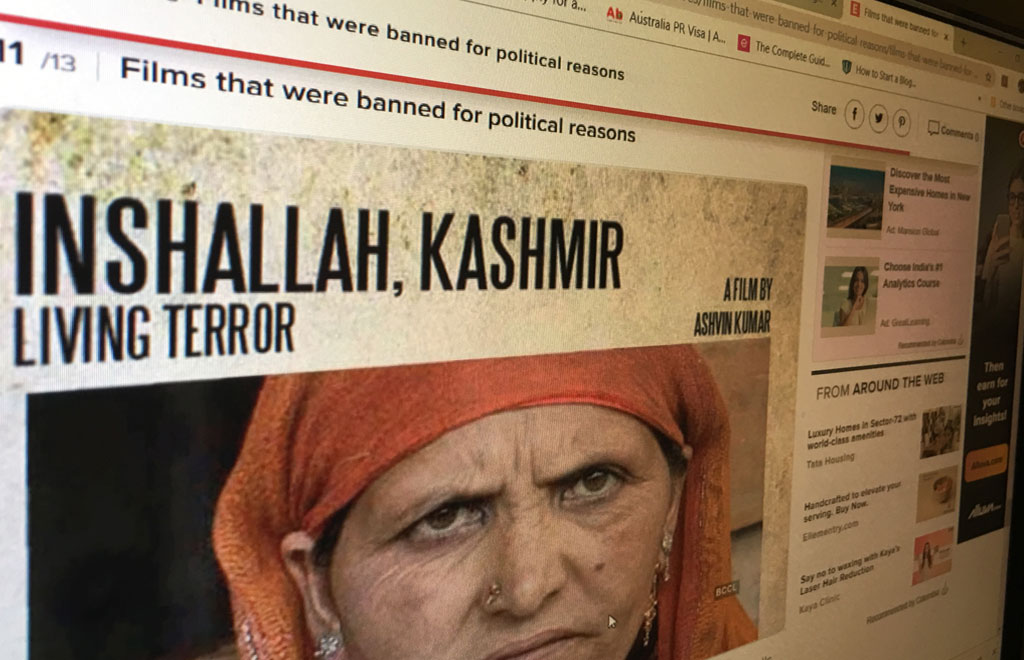I have never been to Kashmir. The only Kashmiri’s I knew were the smiling shawl sellers who used to come with the advent of winter, even 10 years back. At least in my Delhi neighborhood, I don’t see them anymore.
They too have disappeared.
I also don’t get to watch much of news, unless someone pays me for it, but I have heard that article 370 has been scrapped. I don’t understand the implications of that fully, but that does raise some questions in my mind.
When I started searching for answers I chanced upon this old documentary on you tube.
It’s called ‘Ishallah Kashmir: Living Terror’, directed by Asvin Kumar.
And then, I thought, maybe, I could attempt my first ever film-review here, of that documentary. It gives ignorant armchair researchers like me a glimpse into what the common Kashmiri wants.
Furthermore, it’s an interesting film, and a fair enough example of classical investigative documentary structuring, which makes it like a text-book to students of cinema. The director has spent lots of time browsing through footage – by his own admission, and strung together a story out of scattered inputs. That sounded familiar. And since ‘Ishallah Kashmir’ won a National Award – I will basically appreciate something that the democratic republic of India has already validated.
The film begins and ends with the same case-study. Interesting technique; someone from subaltern India being hassled in mainland India for their ethnic or linguistic origin – now why does that ring a bell of familiarity?
The film sets up its premise through a voiceover that talk about 2156 unidentified bodies in 38 grave sites as an admission of crimes committed by the Indian state against the Kashmiri civilians. This is then followed by languid testimonials from former militants. They narrate how interrogators from the Indian Security Forces poured petrol down the rectum of suspected terrorists, and how one man was made to hang from a pole, bound with metal wires. After a while, this man fell down, while his hands, cut by the metal in the wires, remained hanging above.
Putting such vivid description of third-degree torture of suspected militants right in the beginning definitely grabs the attention of the viewers.
This runs for around 7 minutes of the film; after this, the structure is more or less classical ‘investigative’, with a few interesting asides or breathing spaces; in total, about nine narrative voice-offs by the director himself (a commendable personal touch) and around 23 interviews tell the 80 minutes odd story. Of these, 6 interviews are that of ex-militants, 13 of affected civilians/families, 2 lawyers and one of a former Government of India Commissioner from the state, who almost plays the role of an anchorperson, giving erudite explanations and contexts, across the film.
A chief minister appears in a brief aside with an ex-militant, but he doesn’t say much, apart from revealing the fact that he has never met a militant face-to-face before.
The documentary takes the form of a streamlined collage after its initial burst. It’s divided in around ten thematically interconnected chapters, with explanatory chapter heads, sometimes in poetry.
Let’s go chronologically. I’ll keep it brief.
Chapter one, entitled a research trip, and after the title sequence, introduces the core of the problem. It explains how, from the time of Akbar the great, Kashmiri’s have felt that they have been ruled by outsiders. It describes how the people of Kashmir voluntarily acceded to India during partition, the Indo-Pak tussle over Kashmir; the elections of 87 where siding with the United Muslim Front was considered siding with Pakistan; about how the pro-Azaadi element got decimated because it was equated with the pro-Pakistani element… and so forth.
I can’t probably tell the entire story here. You should watch the film, if the premise interests you (you can buy it from YouTube like me); let me just give you the flow, with a few observations.
A natural lead-out from the archaic history of Mughal occupation brings us to the more recent past, of the Dogra Hindu rulers before partition and how they employed the minority Kashmiri Pandits to administer over a majority Muslim population. They lived side by side for centuries till the time came when the Pundits were forced to leave Kashmir in fear, in a mass exodus. Asvin takes us to the story of someone who didn’t flee the valley. Sections of the story he narrates does raise some questions about the nature of the events that led to this exodus, which was almost like a coordinated attack on the minorities. The director didn’t expand on the idea too much, but did take enough time to show the ravages, the burnt houses of the Pundit families and the complexity of the event.
From thereon, the documentary moves on to one poignant story after the other; the section entitled ‘Missing or Disappeared’ starts by mentioning the 1500 ‘half-widows’, 10000 disappeared men, 32,000 widows and 100,000 orphans of Kashmir. The ‘missing or disappeared’ question is about the ones allegedly picked up by the security forces as suspected militants; this included 8 year and 13 year old boys.
The story then gets back to the militants we met at the top of the film – depicting their genesis story, training in Pakistan etc. This also has an interesting sub section with a Kashmiri Pundit couple, who were abducted by militants. They ended up becoming their saviors. More than the couple – the section brings out the human face of the ‘militants’, which I believe was the intended purpose of the director. Juxtaposed with spine-chilling matter-of-fact interviews of past militants, this Pundit couple story once again shows the directors sense of balance.
I enjoyed the cross cutting between bites in this segment – intelligent documentary storytelling, where a word or an idea in a bite leads to the next bite. Those things take helluva lot of time to find and patch together.
I also particularly enjoyed a brief segment where children are playfully blocking the roads – as their own version of a curfew. This is where, for the first time, we hear the slogans of ‘azaadi’ that we never get to hear in mainstream media of main-land India. All in a spirit of playful banter, that is.
The film takes us next to ‘Dardpora: abode of pain’, or the village of over 300 widows and 120 orphans. Most of the men killed here were militants, along with some civilians. Here we also get to know the origin story of Bashir Baba, ex-commander of Hizb-ul-Mujahideen. He shares with us why it is so difficult to get out once you get into the band of militancy – and the concept of ‘ikhwan’, or renegade – surrendered militants that are coerced to work for the armed forces. Dun’no why that reminds me of Salwa Jadum…is there a similarity somewhere!!!
The director (thankfully) didn’t give a separate chapter head to the next story – but takes us, without much ado, to the village of Kunan Poshpora, where, victim women and men talk about their sordid experiences. Allegedly 40 women were raped in a single night here. The director combines this with other rural stories of use of violence by the armed forces and militants alike. I would have done the same – shows his sense of balance and aversion for melodrama, again.
The ‘Kids in conflict’ is a rather brief but touching segment about the impact of this civil war like situation on kids – with one central character, a fast bowler who lost his legs in accidental crossfire, and can never become an athlete now. The jovial tone in which the director starts his interview, asking him if he had ever broken a wicket, makes the revelation even more painful. Nice progression of content – it’s non-linear in its revelation, hence more effective.
At the end, the film returns to Malik Sajid, the cartoonist we saw at the beginning. He tells the story of his harassment by the police when he was invited to Delhi, and draws the curtains with a statement that sums up the story as well.
He says, “I have no identity, you know. There I am being treated as a terrorist; here I am being treated as a slave…I need my space; badly, we need it.”
The hesitant silence in his eyes reveals much more than he speaks.
Since this film won a National Award for best investigative documentary in 2012, and since I have absolute faith in the integrity of those awards and the wisdom of those who give them, I believe most events depicted in the film are real. They don’t give National Awards without doing background fact-checks.
Writer Director Asvin Kumar has since made a full length feature film on another story from Kashmir, called ‘No Father’s in Kashmir’. I am yet to see it.

For me, I have never known what it means to be a civilian monitored by armed forces that are conditioned to believe that they are fighting a war and everyone is an enemy unless proven otherwise!! I do not know what it means to seek freedom from an occupancy that suspiciously feels like a colonial stronghold!! I have never felt the pain of being uprooted from my birth-land due to religious differences!! I can’t really understand the agony of a people living in constant fear of being caught in a crossfire that’s definitely not of their own making!! I can’t say how it feels like to live in a fragmented land, where half your relatives and friends are just across the border, but you can’t meet them at will.
I can’t say all these things about Kashmir.
I am just a Bengali; not even a Bangladeshi, for that matter. They call us Indians now.


Be First to Comment